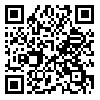Volume 14, Issue 55 (6-2024)
NCMBJ 2024, 14(55): 61-72 |
Back to browse issues page
Download citation:
BibTeX | RIS | EndNote | Medlars | ProCite | Reference Manager | RefWorks
Send citation to:



BibTeX | RIS | EndNote | Medlars | ProCite | Reference Manager | RefWorks
Send citation to:
Parastar H, Farahpour M R, Shokri R, Jafarirad S, Kalantari M. The investigation of antibacterial activity of bohemite-gold and bohemite-gold-chitosan on bacteria causing infection in skin wounds. NCMBJ 2024; 14 (55) :61-72
URL: http://ncmbjpiau.ir/article-1-1682-en.html
URL: http://ncmbjpiau.ir/article-1-1682-en.html
Department of Clinical Sciences, Faculty of Veterinary Medicine, Urmia Branch, Islamic Azad University, Urmia, Iran , m.farahpour@iaurmia.ac.ir
Abstract: (869 Views)
Aim and Background: Nanocomposites are prepared from various materials that may have antibacterial activity. This study aimed to investigate antibacterial and antifungal activityies of nanocomposites of bohemite-gold and bohemite-gold-chitosan by help of aqeous extract of peppermint.
Material and methods: In the current study, the nanocomposites were prepared by exextracellular biosynthesis and antibacterial properties were investigated by minimum inhibitory concentration (MIC), minimum bactericidal concentration (MBC) and killing-time curve by classic method of consecutive dilutions by Clinical & Laboratory Standards Institute.
Results:The results showed that MIC and MBC were 10 µg/mL and 20 µg/mL for bohemite group, respectively. The results also showed that MIC and MBC were 2.50 µg/mL and 5 µg/mL against Acinetobacter baumannii and 5 µg/mL and 10 µg/mL against Escherichia coli, respectively. The greatest antibacterial activity for of bohemite-gold and bohemite-gold-chitosan was observed for a period of 6 to 24 h. Based on ourfindings, bohemite showed lower antibacterial activity compared with bohemite-gold and bohemite-gold-chitosan against the mentioned bacteria.
Conclusion: The prepared nanocomposites did not show any antifungal activity. Thus, bohemite-gold and bohemite-gold-chitosan nanocomposites have antibacterial activities against bacteria inducing infection in wound.
Material and methods: In the current study, the nanocomposites were prepared by exextracellular biosynthesis and antibacterial properties were investigated by minimum inhibitory concentration (MIC), minimum bactericidal concentration (MBC) and killing-time curve by classic method of consecutive dilutions by Clinical & Laboratory Standards Institute.
Results:The results showed that MIC and MBC were 10 µg/mL and 20 µg/mL for bohemite group, respectively. The results also showed that MIC and MBC were 2.50 µg/mL and 5 µg/mL against Acinetobacter baumannii and 5 µg/mL and 10 µg/mL against Escherichia coli, respectively. The greatest antibacterial activity for of bohemite-gold and bohemite-gold-chitosan was observed for a period of 6 to 24 h. Based on ourfindings, bohemite showed lower antibacterial activity compared with bohemite-gold and bohemite-gold-chitosan against the mentioned bacteria.
Conclusion: The prepared nanocomposites did not show any antifungal activity. Thus, bohemite-gold and bohemite-gold-chitosan nanocomposites have antibacterial activities against bacteria inducing infection in wound.
Keywords: Nanocomposite, Chitosan, Bohemite, Gold, Acinetobacter baumannii, Escherichia coli, Infected wound, Iau Science.
Type of Study: Research Article |
Subject:
Physiology
Received: 2024/08/13 | Accepted: 2024/06/30 | Published: 2024/06/30
Received: 2024/08/13 | Accepted: 2024/06/30 | Published: 2024/06/30
Send email to the article author
| Rights and permissions | |
 |
This work is licensed under a Creative Commons Attribution-NonCommercial 4.0 International License. |




